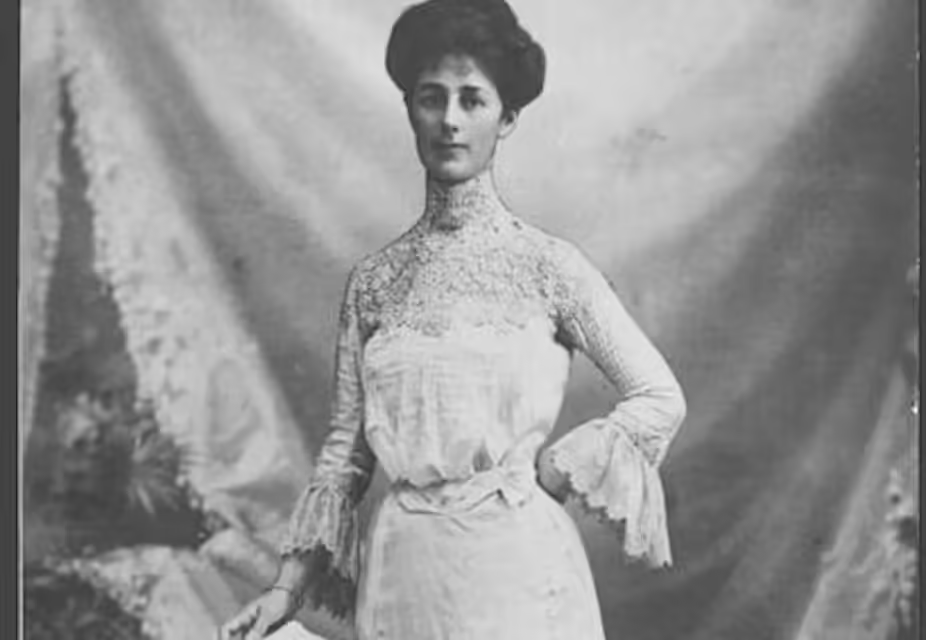Reading time: 20 minutes
In February 1902 – just 13 months after the Australian colonies federated to become the world’s newest nation – a tall, slender woman from Portland, Victoria, was standing outside the door to the Oval Office in Washington DC. She had been summoned to the White House as somewhat of a curiosity.
By Clare Wright, La Trobe University
Intelligent, inquisitive, and quite often irreverent, the young woman waited until she was bidden to enter. When the door opened she saw President Theodore Roosevelt, sitting with his feet up on the desk. He rushed to greet the elegantly attired woman, grabbing her hand and pumping it up and down in his vice-like grip. He shouted:
I am delighted to meet you. You’re from Australia; I’m delighted to hear that.
And with that enthusiastic embrace, Vida Goldstein became the first Australian to meet an American president at the White House. Goldstein was in Washington as Australia and New Zealand’s sole delegate to the International Woman Suffrage Conference. Goldstein addressed huge American audiences on one of the most controversial global issues of the day: Votes for Women.
Campaigning for women’s suffrage was what Goldstein termed “the policy of concentration”. The parliamentary vote was, in Goldstein’s words, “the right that covered all other rights”. She decried:
… the futility of working piecemeal for the emancipation of women, without the vote.
Only the vote, Goldstein argued, would ensure “the protection and prevention of degraded womanhood”. Only the vote would unravel the vast web of legal, economic and social disadvantage that ensnared women and girls the world over.
Furthermore, Goldstein ardently believed that women should enter parliament, as Australian women alone in the world were entitled to do. She argued:
I have always maintained that wherever there are women’s and children’s interests to be considered, women should be thereto consider them.
Such a simple premise; such a revolutionary idea.
Goldstein’s six-month US lecture tour was met with a diva’s reception. Though prim in fashion and chaste in manner, she was both enfant terrible to the established order and darling of the avant-garde. Daily newspapers across the country covered her sold-out lectures on the topic of “The Australian Woman in Politics”.
Goldstein held no doubt about her subject’s international importance and interest, or her country’s political superiority. But why, in that second northern winter of a new century, did the commander-in-chief of the United States of America seek an audience with a charismatic activist from the deep planetary south?
The simple answer is that Teddy Roosevelt was a political progressive. Goldstein was the most fully enfranchised woman he could yet hope to meet and he was keen to see what a member of this new breed looked like. While Roosevelt was a steadfast believer in votes for women, the American Congress would not abide it.
US congressmen put up the same arguments as conservative opponents to universal adult suffrage the world over, including numerous anti-suffrage women. In the words of one Australian politician, if women could vote, what would prevent them from seeking:
… to assume to themselves the functions of men?
Yet the woman now taking tea with the president was decidedly feminine, despite the fact that she came from the country where women had more political rights than anywhere else in the world.
In 1893, New Zealand had become the first country to give women the right to vote in national elections. But in 1902, the newly federated nation of Australia became the only country where white women could both vote and stand for election on a universal and equal basis with white men. This dual right – the complete electoral franchise and eligibility to sit in parliament – was what political philosopher John Stuart Mill termed:
… perfect equality, admitting no power of privilege on the one side, nor disability on the other.
In the very moment of its creation, Australia had instantly become a world leader. And Roosevelt, as he told Goldstein at their meeting, would be “keeping [his] eye on Australia”. He considered its experiment in equality “a great object lesson”.
Comparing Australia and America
Australia’s geopolitical claim as one of the oldest, most stable, and most inventive parliamentary and social democracies has been well established. The secret ballot, the eight-hour day and the wage arbitration system are regularly touted as democratic landmarks with Australian origins.
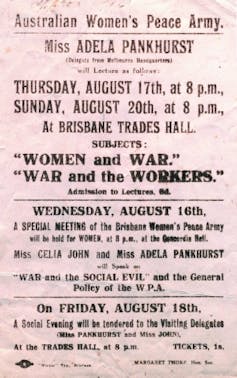
Yet Australia’s inimitability with regard to women’s political equality has barely entered conventional studies of political history. The women’s suffrage movement is more commonly treated as a discrete topic of investigation: a picturesque mainstay of the equally niche field of women’s and gender history, as if the achievements and legacy of the suffrage campaigners and their supporters are merely a quaint nook in the colossal edifice of nation-building.
But at the turn of the 20th century, Australia’s world-leading status as a democratic freedom fighter was no secret. In her opening address to the Washington Conference in 1902, American Suffrage League president Carrie Chapman Catt was unequivocal, if somewhat bemused, in locating Australia at the apex of women’s political liberation.
The little band of Americans who initiated the modern [suffrage] movement would never have predicted that…the island continent of Australia, then unexplored wilderness, would become a great democracy where self-government would be carried on with such enthusiasm, fervor and wisdom that they would give lessons in methods and principles to all the rest of the world.
Catt then specifically referred to Goldstein as the bearer of these unexpected lessons. Australia, said Catt, was “associated in our memory of childhood’s geography as the abode of strange beasts and barbarians”. Yet remarkably, this bizarre land now:
… sends us a full, up-to-date representative woman, widely alive to all the refinements of life, and fully cognisant of all the rights of her sex.
Goldstein was both the literal messenger and a representative of the feminist ideals that Catt associated with Australia. Goldstein was fully aware of the leadership role she had been asked to play. She told a packed house during her address to the 34th American National Suffrage Convention in Washington in March 1902 that:
Woman suffrage is with us to stay, and that our success may hasten the day when you American women will stand before the world as political equals of your menfolk is the earnest desire of the countries which have sent me here to represent them at this great conference.
But it was not always a relationship of mutual admiration. Goldstein was critical of her host country. She told Australian audiences:
Most of us regard America as the most democratic and advanced country politically in the world. Instead it’s as conservative as a country can well be. A democratic form of government does not necessarily mean that the people rule.
Goldstein offered an analysis of the root cause of the hypocrisy:
[America’s] written and hidebound constitution [has] played directly into the hands of moneyed and unscrupulous politicians.
What’s more, Goldstein argued:
… an abnormal material individual prosperity has contributed towards keeping [Americans] in that hypnotic state under the political machine.
In general, Goldstein was a fan of Roosevelt, but she was not a sycophant. Never one to be patronised, she cheekily parroted Roosevelt’s own words to her. She wrote:
The [Australian] Federal Franchise Bill is the greatest step in the direction of political equality that we have yet seen, and must be a splendid object lesson [her emphasis] to every civilised country in the world.
With this line, Goldstein managed both to cock a snook at the US president and highlight her own country’s political superiority.
Changes at home and abroad
If America was slow to take the Australasian lead, by 1908 Finland and Norway had joined Australia and New Zealand in enfranchising women. But imperialism connected British suffragists more closely to the Australian electoral experiment, providing inspiration and example.
In 1911, Emmeline Pankhurst, on behalf of the Women’s Social and Political Party, recruited Goldstein to address the legions of women who were engaging in mass demonstrations and participating in targeted acts of property destruction. Thousands filled lecture halls and theatres to hear Goldstein’s speeches in support of the militant British suffrage campaign.
By this time, unconvinced that gentle persuasion would make a jot of difference, the suffragists were bombing politicians’ residences, setting hedge fires, breaking windows, staging mass street protests, going on hunger strikes and being force fed through nasal tubes by prison guards. The British experience of suffrage advocacy could not have been more different from Australasia’s peaceful struggle for women’s rights.
While in England, Goldstein formed the Australian and New Zealand Women Voters Association (London):
… with the hope that women of enfranchised dominions would help the women of England in their fight for political freedom.
Goldstein also compiled a pamphlet, The Political Woman in Australia, widely circulated in the UK, Europe and the US for propaganda purposes. She was always at pains to point out that, lo, the sky had not fallen and women had not been unsexed by their new political identity as equal citizens.
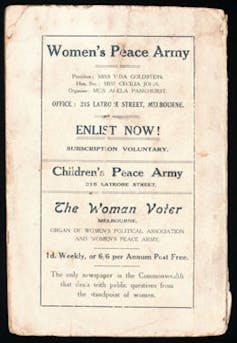
By 1910, Australia had become known around the world as a “social laboratory” celebrated for its pioneering welfare legislation. Some commentators attributed Australia’s capacity for experimentation to “a new land like ours, with a restless go-ahead population”.
Suffragists, however, were keen to stress the gendered nature of Australian progressivism, and were quick to note how crucial votes for women had been in igniting the flame of social change. It was the “woman citizen”, claimed first-wave feminists, who mobilised trade union support for equal pay and other measures of social equity.
There were other concrete markers of the impact of female citizenship rights on women’s living conditions. Prior to winning the franchise, the infant mortality rate in Australia was 111 deaths per 1000 babies. A decade later, the rate had dropped to 77.
Goldstein attributed the decline in infant mortality to the introduction of pure food laws and raising the age of consent. South Australia, the first Australian colony to enfranchise women in 1894, was also the first legislature in the world to require an “illegitimate father” to recognise his financial obligation to the mother of his child through a law called the Affiliation Act, passed in 1898 after lobbying from women’s groups.
Further examples of progressive and protective actions initiated by women were pensions for invalids, pure milk laws, early closing hours for pubs and technical education for girls. Goldstein called these and other measures the “social reform legislation for which Australia is noted”.
Goldstein directly attributed the success of reformist legislation to the mobilisation of female voters – many of whom would sit in the galleries of the parliament when any bill affecting women and children was debated and then interview members of parliament to urge alterations and amendments.
Suffrage as part of a wider movement
In Australia, the suffrage dream was closely aligned with other utopian visions of social and political transformation.
Sparked by the gold rushes of the 1850s, a potent amalgam of socialists, spiritualists, dissenters, eclectics, theosophists, pacifists, feminists, unionists, Unitarians, vegetarians and garden-variety liberal democrats all converged on Australia in a remarkably non-volatile brew of ideas and optimism.
By the late 19th century, Australia’s utopian dreamers were not fringe-dwellers. They were bona fide members of Melbourne’s legal, political, religious and social establishment. Like future prime minister Alfred Deakin, most of this clique were civic leaders, sometimes referred to as “the honest doubters”.
As many women’s rights activists realised, federation was the ultimate test tube in which the experimental social and spiritual optimism of the honest doubters would be crystallised.
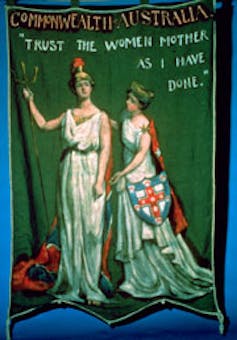
The birth of the Australian Commonwealth was channeled through a series of constitutional conventions held in Melbourne, Sydney and Adelaide from 1890 to 1897. The issue was never really whether the six Australian colonies would federate, but how. This would require diminishing the power of the colonies or expanding some of their laws to benefit all citizens across the new Commonwealth.
This jurisprudential reality meant that, just as the mobilisation of the international women’s movement was reaching its apex, there was suddenly a high-profile public platform on which activists could argue the case.
With spitfire efficiency, women’s suffrage organisations around the country lobbied delegates to the federal conventions. The Womanhood Suffrage League of New South Wales (WSL), an association founded by Australian newspaper editor Louisa Lawson, submitted a petition to the Australasian Federal Convention in 1897. It was one among the hundreds sent by women’s groups to convention delegates, lobbying for women’s voting rights to be enshrined in the new Australian Constitution.
Leveraging the precedent of South Australia, which had already given women the right to vote and to stand for parliament, the WSL’s petition urged delegates to:
… consider whether or not such franchise shall be uniform throughout all the colonies.
It was this question of uniformity – whether all women would now achieve federally what South Australian women had won locally in 1894 – that set Australia on its course to democratic distinction. The rampart was raised for a showdown between colonists’ rights versus federal rights, with woman suffrage as the battering ram.
Frederick Holder, a keen federalist and treasurer of South Australia when women won their historic victory in 1894, insisted that any agreement honour the existing rights of individual colonists. At the 1897 convention in Adelaide, Holder and Charles Kingston, South Australia’s premier, proposed that full voting rights for all white adults should be written into the Constitution.
Holder moved to add a clause that read:
No elector now possessing the right to vote shall be deprived of that right.
Other delegates were horrified. Edmund Barton, who would become Australia’s first prime minister, saw the writing on the wall. He railed:
As I understand the suggestion, it means that if the federal parliament chooses to legislate in respect of a uniform suffrage in the Commonwealth, it cannot do so unless it makes it include female suffrage.
If South Australian women could not be stripped of their hard-won electoral rights, then the rest of Australia’s women must perforce gain them. Barton’s conclusion was inexorable:
It ties the hands of the federal parliament entirely.
If the clause were not approved, Holder and Kingston threatened that South Australia would vote against joining the Commonwealth. Despite Barton’s protests, a poll was taken and the ayes won by three votes.
Two men from South Australia, backed by every progressive woman’s organisation on the continent, had effectively made white women’s suffrage the precondition of a federated Australia.
The racial qualifier is key. The earlier legislation that entrenched the White Australia Policy – the Immigration Restriction Act of 1901 – was also the crucial prerequisite that made Goldstein the freest of the free when she visited America in 1902.
Further, in preserving the existing rights of colonists and extending them to all white adults, the Franchise Act of 1902 had stripped Indigenous Australians ofvoting rights. As historian Susan Magarey has argued:
Citizenship, as defined by the right to vote, could be sexually inclusive, because it had just been made racially and ethnically exclusive.
Race, not gender, defined the new Australian citizen. Historian Marilyn Lake has argued that in an international context, the federal female franchise ushered in an era of unprecedented political power for women. But what did people at the time make of the opportunistic alignment of feminism and federalism?
Spreading influence
The majority of political pundits reckoned that the social laboratory had not spawned a monster. “Votes for Women: Australia Satisfied – Letting the Empire Know”, trumpeted a newspaper headline in 1910, following the Senate’s decision to communicate to the British prime minister that Australia had “found [the] experiment a success”.
Wrote another journalist:
The result has not produced either a heaven or a hell.
The Australian suffrage campaigners were correct to see federalism as their ticket to public influence on the grandest scale. Leaders like Goldstein readily adopted the role of international ambassador for the enlightened dawn of a new century.
On April 12, 1907, Goldstein wrote to members of the parliaments of Australia as President of the Women’s Political Association. “Dear Sir,” her letter began – for there were as yet no female parliamentarians, despite Goldstein’s own efforts to become a senator in 1903:
We Australian women who have had our right to political liberty granted by the national parliaments and by every state parliament save one [Victoria], have been appealed to by the International Woman Suffrage Alliance to help our less fortunate fellow women in other lands.
The appeal was most forthcoming from nations:
… where it is urged by those in authority that the enfranchisement of women means social and political disaster.
Goldstein pressed the statesmen to write testimonies to the successful workings of complete adult suffrage in Australian political life. She was obliged with an avalanche of letters, including responses from Prime Minister Alfred Deakin, as well as testimonies from the attorney-general, postmaster-general and state premiers.
Even former opponents to women’s suffrage like Thomas Waddel, the colonial secretary of NSW, testified that women:
… exercise the franchise wisely and I feel sure that their influence in public life will be all for good.
Goldstein was able to forward a thick stack of letters of endorsement from respectable and influential men to the campaign leaders of her “less fortunate fellow women” abroad.
On November 17, 1910, the Senate went one step better in touting Australia’s democratic credentials when it unanimously passed the Votes for Women Resolution – a confidence motion in its own first decade of nationhood. The motion read:
Because [universal suffrage] has brought nothing but good, though disaster was freely prophesised [sic], we respectfully urge that all nations enjoying representative government would be well advised in granting votes to women.
If this sounds fresh, there was more hubris to come.
Our young Australian nation is bound to achieve greatness.
Why such a glorious destiny? Because Australia was, in the words of the senators, “the first nation to make justice the foundation of its constitution”. And it was not just women who thought as much. The motion concluded:
Woman suffrage has done for Australia all and more than its leaders claimed for it. No self-governing country can prosper without the political aid of women. It is a necessary factor in securing the moral and spiritual progress of the individual and of the nation.
The senators were highly aware of the inherent role reversal in the colonies giving political tuition to the Empire. One claimed that Australia – though the child – had every right to give advice to Britain – the mother. His rationale?
We are, in politics, the pacemakers of the world.
Copies of the Senate’s bumptious resolution were circulated and published abroad.
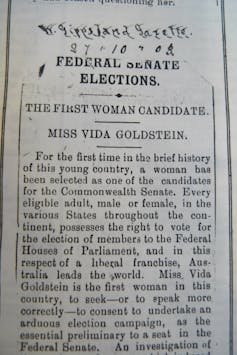
Judging by the 1910 Senate’s vote of self-confidence in its own destiny, the auspicious occasion (if there must be just one) when Australia overcame its self-doubt and believed itself to be a nation, in fact occurred prior to any military battle on foreign soil.
Five years before Gallipoli, the Commonwealth of Australia asserted that it was “bound to achieve greatness” because of its democratic agility and proficiency, its sociopolitical courage and grace.
It might even be that the establishment of the Anzac legend and the trumpeting of a distinctive, world-leading constitutional equity were two sides of the same coin. “Both the feminist/reformist/federation story and the masculinist/digger/Gallipoli story” assumed that Australia could create a new imperial nation that would simultaneously embody racial superiority while rejecting the political inequalities and hierarchies of the old world.
Though not all first-wave feminists agreed, militarism and maternalism were not necessarily mutually exclusive. The belief that Australia had something valuable to contribute to the world continued beyond the disastrous landing at Gallipoli on April 25, 1915.
In 1917, six years after Goldstein’s sold-out lecture tour of Britain and at the height of the Great War, the Australian Commonwealth once again agreed to send a message to the world. While ostensibly a message of hope to King George V, it was not a felicitation for his newly named House of Windsor, nor a pledge of solidarity for the war effort. It was, instead, an appeal for political reform, bordering on a taunt to keep up with the precocious Australians.
The parliamentary missive began:
Appreciating the blessings of self-government in Australia through adult suffrage, we are deeply interested in the welfare of the women of the Empire and we again humbly petition Your Majesty to endow them with that right of self-government for which they have petitioned for nearly three-quarters of a century.
Perhaps this can be read as the trademark tactic of an adolescent, cutting an arrogant parent down to size with evidence of her own incompetence. But more likely, Australians were deeply aware of the unique contribution they had made to the advancement of democratic principles and institutions – a profound sense of commitment to the international cause of political equality, spurred on by confidence in their own social experiment of change and reform.
Maturity was not simply tested by readiness for war. And “growth” was not measured in imperial pencil marks on a military doorframe, but by more psychosocial notions of human development. Australia was justly proud that its first success had been the peaceful negotiation of the transnational need for women’s political emancipation.
As Bishop JE Mercer argued in his contribution to Goldstein’s cache of support letters:
Australia was reaping the reward of having responded to the unanswerable appeal to justice.
Selling the campaign
In the decade that followed the Washington International Suffrage Convention, the Australian press was also keen to herald Australia’s landmark status on the American political landscape.
“American Suffragettes. Praise for Australia”, screamed one newspaper headline, when a deputation of American women’s rights activists appeared before the Home Rules Committee of the House of Representatives in December 1913. The Australian experience of women’s suffrage was “quoted in favour of the proposal” by the deputation.
The Melbourne Argus similarly reported American suffragists’ disappointment and disgust when Woodrow Wilson failed to mention the American women’s suffrage campaign in his Congressional Christmas address in December 1913.
Why would a Melbourne newspaper consider this seemingly immaterial aspect of American domestic policy relevant to its readers, other than as a tacit nod to Australia’s continued primacy in progressive legislation? Pride in Australia’s democratic superiority endured. Australian newspapers consistently reported Wilson’s inability to get a universal suffrage bill through Congress throughout the war years.
As historian Hilary Golder has argued, though many Australian feminists in the Federation era were strong nationalists (as well as pacifists), they leapt at the opportunity to become involved in international suffrage campaigns, lending guidance and advice as well as participating in “performative activism”.
It was possible to be both proud Australians and loyal “women of the Empire”. In June 1911, Australians Alice Henry, Dora Montefiore, Nellie Martel and Murial Matters joined with Goldstein and Margaret Fisher, wife of Australia’s then-prime minister Andrew Fisher, to march in the Great Suffrage Petition in London.
Goldstein and Fisher carried a banner on behalf of Australia and New Zealand imploring England to:
Trust the women, Mother, As I Have Done.
The banner, painted by the Australian expatriate artist Dora Meeson Coates, dripped with symbolism. It depicted a young woman bearing a shield of the Southern Cross, humbly petitioning a maternal Britannia to listen to her cause. Maiden Australia’s hand is upturned in supplication; Mother England stares diffidently into the distance.
The image is not one of cross-gender antagonism, but of intergenerational conflict and negotiation. In the mother–daughter dyad, the psychic health of the daughter requires that she go her own way, but not antagonise or hurt the resentful mother, who needs her to remain a beloved friend and comrade.
The antipodean suffrage banner can be read as a symbolic cutting of apron strings. Mother England gives her colonial daughter the cold shoulder; the nubile offspring must stand her ground. This feminised coming-of-age story, implicit in Australia’s critical role in the British suffrage campaigns, provides an alternative to the androcentric underpinnings of Gallipoli’s enduring “birth of a nation” mystique.
If the philosophical and practical leadership of women in stewarding Britain through a time of political upheaval focused on women’s transnational relationships, as Goldstein herself noted:
… one feature in the Suffrage Campaign in Australia makes it radically different from that in any country – the readiness of our men to admit that our cause was a just one, and entitled to immediate recognition.
Goldstein may be overstating her case, given that the Australian suffrage campaign began as early as 1869 and thus lasted 33 years. Also, other suffragists described Australian men as behaving like pompous benefactors or as surrendering reluctantly to the inevitable. In April 1902, Jessie Ackerman bemoaned the number of politicians who put themselves on a pedestal:
… halo in hand, to anoint himself high priest, and claim the glory touch of shepherding the women into the kingdom of federal citizenship.
Ackerman was quick to point out that the Commonwealth parliament enfranchised its women because it had no constitutional choice. She concluded:
There is, therefore, little credit due to an “unbounded generosity” on the part of men. There was no alternative.
Goldstein believed that in Australia, the political faultline lay not between men and women, but between conservatives and progressives. She also criticised Australia’s self-styled “new women” for their own failure to fulfil the promise of their early electoral equality.
Returning to Australia after the intense fellowship and purpose of London’s mass demonstrations and overflowing lecture theatres, Goldstein began to despair that after a decade of voting rights but no elected female representation, Australian women seemed to have lapsed into an apathetic status quo. “Enfranchised women of Australia,” she beseeched her sisters from street corners, copies of her Woman Voter journal in hand, “rise to your responsibilities, to your potentialities”.
Though the absolute numbers of female voters almost doubled between 1903 and 1910, Goldstein was not convinced that women were doing enough to prove that female political power was a force for good. Goldstein had an evangelical vision of Australia’s global mission that was not dissimilar to the male advocates of the federalist movement, who viewed Australia as a salve to old world ills.
The Brisbane Worker had declared in January 1901:
From the first to the last keynote of Australian provincial progress has been democracy, this is Australia’s manifest destiny if she is to fulfil any nobler destiny than the nations decayed and decaying.
Australian suffragists benefited from a timely alignment between the ideals of international feminism and the historical coincidence of federalism – a sense of providence about the role that a new country could play in the worn-out routines of global political housekeeping.
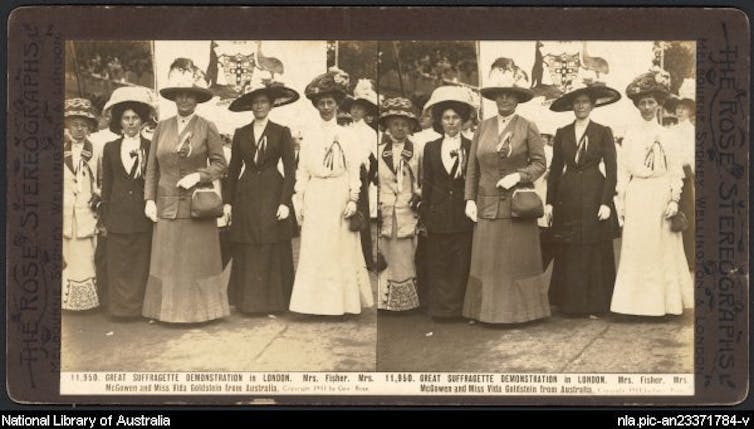
Where are we now?
So what has happened since then to shift the national conversation from Australia’s youthful, maverick mission as a global innovator to a country of politically timorous conformists?
One cultural trend stands out. Australia’s collective memory of the international achievements of its homegrown suffrage movement has faded in inverse proportion to the popularity of the Anzac legend. Militarism has won the public relations campaign for the “birth of a nation” mantle. Most Australian feminists believed as fervently in disarmament as suffrage. It was indeed the latter that should, in theory, have produced the former.
Yet Gallipoli also represented the heady, irresistible triumvirate of militarism, empire and race. But in the wake of a world war, any idea of Australian isolationism seemed increasingly untenable given, as the historian Audrey Oldfield has put it, “the historical imperatives of Australia’s geographical position”.
Most Australian suffragists, including Goldstein, believed whole-heartedly in the wisdom of a White Australia. As the British Empire crumbled under the weight of its own racial pecking orders, American global dominance took hold under Franklin D. Roosevelt.
Underpinned by the same imperialist subservience that ultimately fuelled the Anzac legend, with its heroically active men and patriotically domestic women, the transnational potential for feminists to take a leading role on the world stage was impaired. Australia’s relevance as a youthful ambassador for change diminished as its acquiescent ties to Mother England remained stubbornly tangled.
In October 2011, former prime minister Malcolm Fraser expressed his anxiety at Australia’s lack of political pluck when he addressed an open letter from prominent Australians to Prime Minister Julia Gillard on the issue of the humane processing of refugees. Fraser exhorted:
Seize the opportunity to exhibit leadership, not just at home, but also on the world stage.
Fraser gave a concrete example of the form such moral courage might take: why not implement measures that would “serve as an incentive and an example for members of the UNHCR Working Group on Resettlement, which Australia currently chairs”.
Channelling the ghost of Teddy Roosevelt, Fraser concluded:
Make no mistake, the world is watching. Australia has a chance to not only salvage our reputation but set an example for our friends and allies around the world.
In October 2012, Gillard took up the challenge, though not on the issue that Fraser pre-empted. “I will not be lectured about sexism and misogyny by this man,” Australia’s first female prime minister fairly roared at a smirking opposition leader, Tony Abbott. And the world was watching.
Via the internet, millions viewed “the misogyny speech” in a global fascination with Australia’s female pluck. World leaders rang Gillard to congratulate her on calling out the entrenched prejudice towards women in public and professional life. International journalists used the Australian precedent to focus attention on their domestic politics. As Amelia Lester wrote in The New Yorker:
After his performance last week, supporters of president Obama, watching Gillard cut through the disingenuousness and feigned moral outrage of her opponent to call him out for his own personal prejudice, hypocrisy, and aversion to facts, might be wishing their man would take a lesson from Australia.
US President Barack Obama reportedly mentioned the speech to Gillard when she rang to congratulate him on his 2012 election victory.
Thus, more than a century on from Goldstein’s historic visit to the Oval Office, a hint of antipodean evangelism has recently re-entered the sphere of international politics.
Perhaps, with the global challenges of the 21st century, Australia can reassert its erstwhile youthful exuberance and once again be proud to call itself a trailblazing leader – a nation where justice serves as the foundation of its moral constitution.
This article was originally published in The Conversation.
Podcasts about women’s suffrage in Australia
Articles you may also like

General History Quiz 49
The History Guild Weekly History Quiz.See how your history knowledge stacks up. Have an idea for a question? Submit it here and we’ll include it in a future quiz! Please leave this field emptyTell me about New Quizzes and Articles Get your weekly fill of History Articles and Quizzes We won’t share your contact details […]

10 things every politician should know about history
Reading time: 5 minutes
The federal Education Minister, Alan Tudge, has announced a major edit of the draft history curriculum by the Australian Curriculum, Assessment and Reporting Authority (ACARA) as part of an effort to lift educational standards. “Ultimately, students should leave school with a love of country and a sense of optimism and hope that we live in the greatest country on Earth and that the future is bright,” he said.
The text of this article is republished from The Conversation in accordance with their republishing policy and is licenced under a Creative Commons — Attribution/No derivatives license.

